Investigating the ‘Uncatchable Smile’ in Leonardo da Vinci’s La Bella Principessa: A Comparison with the Mona Lisa and Pollaiuolo’s Portrait of a Girl
Instructor Prep
concepts
Student Protocol
The protocol was approved by the Faculty Research Ethics Committee at Sheffield Hallam University for studies on human subjects.
1. Inter-observation Stage
- Identify how and why La Bella Principessa's expression appears ambiguous.
- Display a good quality, frameless and exact sized foam backed digital copy of La Bella Principessa (33.2 cm in height x 23.8 cm in width) on an easel in diffuse lighting.
- Have four participants discuss the ambiguous expression in La Bella Principessa's portrait. Record the results of the discussion on a piece of paper.
Note: One participant must be the researcher and the others must be recruited from the academic community.
Note: Ensure that the participants can freely approach the portrait from any distance or angle.
2. Structured Interview Stage
- Interview four different participants one at a time and have them answer the questions contained within the structured interview schedule: "Please can you describe the Princess's expression? Do you think there are any differences in the Princess's expression when you view her from close or further away? If so, please explain your answer".
- Display La Bella Principessa's portrait (33.2 cm H x 23.8 cm W) in the center of an A1 paper pad resting on an easel in a well illuminated room.
- Instruct the participants to describe the princess's expression (e.g., happy or melancholic) and note any differences in the expression when viewed from close-up (to within a few centimeters of the portrait) or further away (more than three meters away) from the portrait. Have the participants write down their observations on paper.
- Display La Bella Principessa's portrait (33.2 cm H x 23.8 cm W) in the center of an A1 paper pad resting on an easel in a well illuminated room.
- Conduct a Grounded Theory analysis15,16,17,18 of participants' descriptions to identify the most common words used to describe La Bella Principessa's expression (e.g., smiling, happiness, contentment) and changes to her expression with respect to distance (e.g., less content when closer, etc.).
3. Psychophysical Experiments Stage
- Conduct five experiments to test the five hypotheses formulated on the basis of findings from steps 1 and 2, as outlined below.
- On Viewing Distance (experiment 1)
- Conduct a between-subjects experiment with two independent variables (IVs): Portrait (with three levels: La Bella Principessa, Mona Lisa, and Portrait of a Girl); and Viewing Distance (with two levels: Close vs. Far).
Note: The dependent variable must be perceived contentment (i.e., how much on the scale of 1 to 7 the women in the portraits appear content).- Recruit 60 participants, 10 for each of the six conditions resulting from the combination of the factor levels indicated in 3.1.1.1. Ensure that the participants have normal or corrected-to-normal acuity (determined by self-reporting) and are naive with regard to the experimental design. Ensure that the participants are not familiar with either La Bella Principessa or the Portrait of a Girl and have not seen the Mona Lisa for at least one year.
- Display good quality and exact sized foam backed digital copies of La Bella Principessa (33.2 cm H x 23.8 cm W), Mona Lisa (77 x 53 cm), and Portrait of a Girl (45.5 x 32.7 cm) in the center of an A1 paper pad resting on an easel 1.80 m from the floor.
- Mount the portraits indicated in 3.1.1.1.2 in diffused lighting at the end of a long corridor with two doors 0.5 and 8 m from the portraits, respectively, and cover them with a sheet. Place two markers on the floor, one 0.5 m from the portrait for the Close condition, and the other 8 meters from the portrait for the Far condition.
- Randomly assign participants to the Close or Far condition and to one Portrait condition. Have the participants in the Close condition enter the corridor from the closest door, and the participants assigned to the Far condition enter the corridor from the furthest door.
- Have the participants stop at a location indicated by the marker on the floor and then unveil the portrait. Ensure that the participants are able to see the portrait from the assigned marker only and not experience any change in the viewing distance.
- Have the participants verbally rate the perceived contentment in the expressions of the woman viewed in the assigned portrait on a scale of 1 (not content at all) to 7 (extremely content). Record participants' responses on a piece of paper (e.g., Participant 1; Close Condition; Mona Lisa; Contentment = 5).
- Conduct a between-subjects experiment with two independent variables (IVs): Portrait (with three levels: La Bella Principessa, Mona Lisa, and Portrait of a Girl); and Viewing Distance (with two levels: Close vs. Far).
- On Blur Level (Experiment 2)
- Conduct a within subjects experiment (i.e., each subject is presented with all the experimental conditions) with two IVs: Portrait (with three levels: La Bella Principessa, the Mona Lisa, and Portrait of a Girl); and Level of Blur (with eight levels of increasing blur).
Note: The dependent variable must be perceived contentment.- Recruit 10 participants who have not taken part in any previous stages of the study.
- Create a set of eight digital images for each of the three portraits with increasing levels of Gaussian Blur 12. Ensure that the Blur level increases in steps of 1 pixel over the range 0-7.
Note: In this blurring process pixels take contributions from their surrounding pixels and contributions from the center are de-emphasized. - Set up a 22" (20" viewable) CRT monitor set at a resolution of 1,280 x 1,024 connected to a computer.
- Write software19 (see Supplemental file) that displays the portraits in a random order on the monitor; presents a random noise mask (i.e., a figure made by black and white 1 pixel large dots randomly distributed across the screen) for one second before the presentation of each picture; allows participants to enter their ratings of contentment from 1 to 7 using a keyboard; and records the ratings when the spacebar is pressed.
Note: See supplemental "Code for exp 2.bak" file for an example on how this could be programmed in True Basic19, although other programs can be used. - Seat participants one at a time in a well-illuminated room 50 cm from the monitor.
- Have the participants rate the perceived contentment in the expression of La Bella Principessa, Mona Lisa and Portrait of a Girl from 1 to 7 and enter their ratings using a keyboard. Record the responses when the spacebar is pressed as per step 3.1.2.1.4 above.
- To eliminate any influences from the previous images affecting participants' ratings of the new ones, present a random noise mask full screen that disappears automatically after one second for one second prior to the next image being shown. Allow the image to remain on the screen for as long as the participant desires.
- Conduct a within subjects experiment (i.e., each subject is presented with all the experimental conditions) with two IVs: Portrait (with three levels: La Bella Principessa, the Mona Lisa, and Portrait of a Girl); and Level of Blur (with eight levels of increasing blur).
- On Establishing the Source of the Illusory Effect (Experiment 3)
- Conduct a repeated-measures experiment with two IVs: Level of Blur (with eight levels); and Mask Position (with four levels: No mask, Mouth mask, Eye mask, or both Mouth and Eye masks).
Note: The dependent variable must be perceived contentment.- Recruit 10 participants who have not taken part in any previous stages of the study.
- Use the same digital images of La Bella Principessa with different levels of Gaussian blur used in experiment 2. Using graphical software (e.g., Photoshop), create a solid black rectangle of 0.3 x 0.6 cm and place it over the mouth, or the eye or over both the mouth and the eye.
- Create three more sets of masked images to result in a total of four sets (each comprising eight images): For the first set create eight images for the No Mask condition; for the second set create eight images for the Mouth Mask condition; for the third set create eight images for the Eye Mask condition (of La Bella Principessa's visible eye); and for the fourth create eight images for the Eye and Mouth condition.
Note: The mask itself must not be blurred. See supplemental "Code for exp 3.bak" file for an example on how this could be programmed in True Basic, although other programs can be used. - Use a CRT monitor and the same conditions as for experiment 2. Have the participants rate the perceived contentment of La Bella Principessa on a scale of 1 (not content at all) to 7 (extremely content) by pressing the correspondent key on the numeric keypad.
- Conduct a repeated-measures experiment with two IVs: Level of Blur (with eight levels); and Mask Position (with four levels: No mask, Mouth mask, Eye mask, or both Mouth and Eye masks).
- Distance on Perceived Mouth Slant (Experiment 4)
- Conduct a between-subjects experiment (i.e., different subjects for the different conditions) with one IV (Viewing Distance with two levels: Close vs. Far).
Note: The dependent variable must be the perceived slant of the mouth.- Recruit 20 participants (10 in the Close Condition and 10 in the Far condition) who have not taken part in any previous stages of the study.
- Project an exact sized (33.2 cm H X 23.9 cm W) digital version of La Bella Principessa using a projector onto a screen connected to a computer at 1.80 m from the floor in a large room with diffused lighting.
- Place a wireless keyboard on top of a table at 0.5 m from the screen for the Close Condition. Place the wireless keyboard on top of a table 8 m from the screen for the Far Condition.
Note: Ensure that the sizes of the retinal images of the portrait in degrees of visual angle are the same as for experiment 1. Ensure that the participants view La Bella Principessa from the assigned location only and do not experience any change in the viewing distance. - Using the programming software described above (3.1.3.1.3), create a 0.9 cm long black hairline measurement 'handle' on the screen (the same length as La Bella Principessa's mouth). Place the hairline at the same level and 4 cm to the left of the mouth.
- Make the right side of the handle adjustable by pressing a button of a wireless mouse and record the perceived mouth slant angle when the spacebar key is pressed (see supplemental "Code for exp 4.bak" file).
- Have the participants to adjust the 'handle' using the mouse. Instruct participants to press the mouse button to adjust the slant of the handle until it aligns with the perceived slant of the mouth of the woman in the portrait. Leave the images on the screen for as long as the participant desires.
- Conduct a between-subjects experiment (i.e., different subjects for the different conditions) with one IV (Viewing Distance with two levels: Close vs. Far).
- Blur on Perceived Mouth Slant (Experiment 5)
- Conduct a repeated-measures experiment with one IV (Blur with eight levels).
Note: The dependent variable must be the Perceived slant of the mouth.- Recruit 10 participants who have not taken part in any previous stages of the study.
- Using the same apparatus used for experiment 2 and the same on-screen facility used in experiment 4, present the eight versions of La Bella Principessa with different levels of blur in a random order on the screen (see supplemental "Code for exp 5.bak" file).
- As for experiment 4, instruct participants to adjust the slant of the 'handle' until it aligns with the perceived slant of the mouth of the woman in the portrait. As in experiments 2 and 3 present a random noise mask on the screen one second prior to the next image being shown. Leave the images on the screen for as long as the participant desires.
Note: The software records the perceived mouth slant angle when the spacebar key is pressed.
- Conduct a repeated-measures experiment with one IV (Blur with eight levels).
- On Viewing Distance (experiment 1)
Investigating the ‘Uncatchable Smile’ in Leonardo da Vinci’s La Bella Principessa: A Comparison with the Mona Lisa and Pollaiuolo’s Portrait of a Girl
Learning Objectives
From the negotiation process of the Inter-observation stage it was ascertained that the ambiguity in the Princess's expression might be due to a visual illusion of direction which depends on the viewing distance. Since spatial frequency changes with distance it was concluded that this change relates to spatial frequency. A Grounded Theory analysis of the descriptions obtained in the Structured Interview stage was performed and it was found that observers tended to describe her change of expression in terms of contentment. Therefore, the term ''contentment'' was adopted as the dependent variable for the subsequent experimental stage. Five psychophysical experiments were conducted to test the hypotheses generated in the previous qualitative stages. Experiment 1 supported Hypothesis 1: When La Bella Principessa and the Mona Lisa were observed from a distance their Perceived Contentment was significantly higher than when the portraits were viewed from close-up, whereas there was no significant effect for Pollaiuolo's Portrait of a Girl (see Figure 1). Specifically, in the Far condition the average Perceived Contentment for La Bella Principessa and the Mona Lisa was about 2 and 1.5 units higher (in the range 1 – 7) rather than in the Close condition, respectively;, whilst there was no significant difference for Pollaiuolo's Portrait of a Girl. This finding supported Hypothesis 1. Second, the level of blur affected the Perceived Contentment of La Bella Principessa and the Mona Lisa but not the Perceived Contentment of Pollaiuolo's Portrait of a Girl. As can be seen in Figure 2, increasing the level of blur increased Perceived Contentment in a linear fashion, whilst this experimental manipulation did not affect the Perceived Contentment of Pollaiuolo's Portrait of a Girl. This finding supported Hypothesis 2. Third, the Perceived Contentment of La Bella Principessa increased with the Level of Blur in both the No Mask and Eye Mask conditions whereas there was no significant linear trend between Level of Blur and Perceived Contentment for either the Mouth and both Mouth and Eye mask conditions (see Figure 3). This supported Hypothesis 3 that the uncatchable smile illusion is mainly attributable to the mouth area of the portrait. Fourth, the Perceived Mouth Slant of La Bella Principessa changed with viewing distance; her mouth was perceived to take an upward slant when viewed from a distance, whereas it was perceived to take a downward direction when observed from close-up (see Figure 4). Specifically, in the Close condition the mouth was perceived to take a downwards direction (an average of about 7.5 degrees), whilst in the Far condition, the mouth was perceived to take an upwards direction (an average of about 1 degree). This finding supported Hypothesis 4. Finally, the Perceived Mouth Slant of La Bella Principessa changed with Level of Blur; when viewed with an increasing level of blur her mouth was perceived to take a more upward slant (see Figure 5). Specifically, the mouth slant was perceived to take a downwards slant (an average of about 8 degrees) when no blur was applied; and it took a linear upwards direction when the level of blur was gradually increased. This supported Hypothesis 5.
Figures 1 to 5 show examples of results from Soranzo & Newberry3 to illustrate how the findings from the experiments could appear.
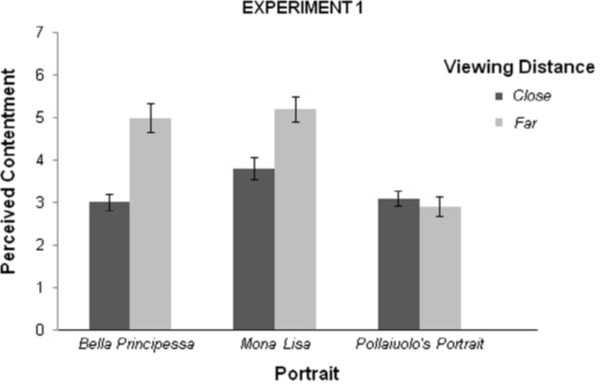
Figure 1. The Effect of Distance on the Perceived Contentment of La Bella Principessa, Mona Lisa and Portrait of a Girl. This figure shows how distance could influence the perceived contentment of La Bella Principessa, Mona Lisa and Portrait of a Girl. Bars indicate standard errors. This figure has been modified from Soranzo and Newberry3.
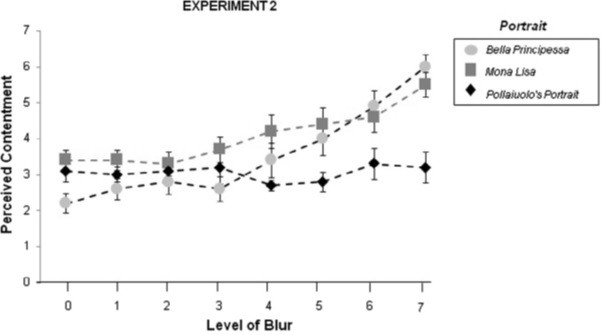
Figure 2. The Effect of Blur on the Perceived Contentment of La Bella Principessa, Mona Lisa and Portrait of a Girl. This figure shows how blur could influence the perceived contentment of La Bella Principessa, Mona Lisa and Portrait of a Girl. Dotted lines favor the view of the trend. Bars indicate standard errors. This figure has been modified from Soranzo and Newberry3.
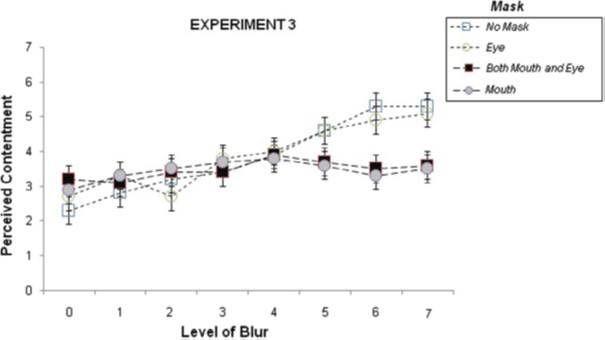
Figure 3. The Effect of Blur and Masking on the Perceived Contentment of La Bella Principessa. This figure shows how blur could affect the perceived contentment of La Bella Principessa when different parts are masked. Bars indicate standard errors. This figure has been modified from Soranzo and Newberry3.
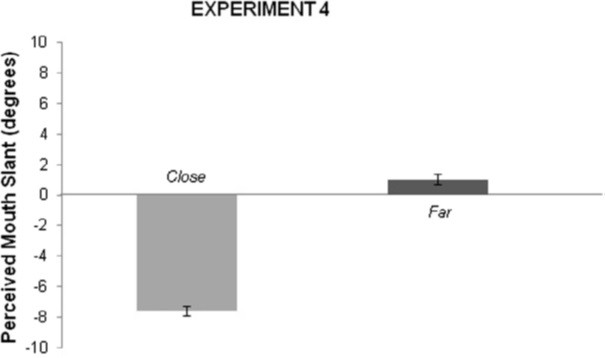
Figure 4. The Effect of Distance on the Perceived Mouth Slant in La Bella Principessa's Portrait. This figure shows how distance could influence the perceived mouth slant in La Bella Principessa's portrait. Bars indicate standard errors. This figure has been modified from Soranzo and Newberry3.
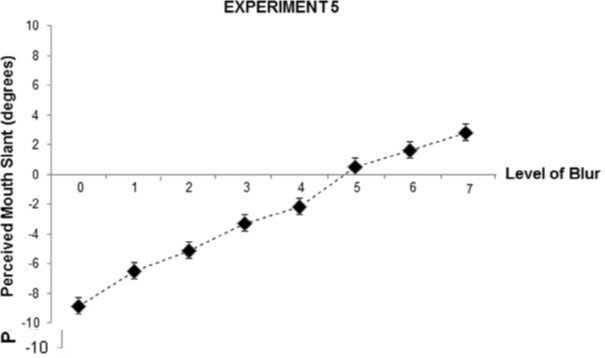
Figure 5. The Effect of Blur on the Perceived Mouth Slant in La Bella Principessa's Portrait. This figure shows how blur could influence the perceived mouth slant in La Bella Principessa's portrait. Dotted lines favor the view of the trend. Bars indicate standard errors. This figure has been modified from Soranzo and Newberry3.
Supplemental file 1. Code for experiment 2. Please click here to download this file.
Supplemental file 2. Code for experiment 3. Please click here to download this file.
Supplemental file 3. Code for experiment 4. Please click here to download this file.
Supplemental file 4. Code for experiment 5. Please click here to download this file.
List of Materials
| High quality same size reproductions of the following three portraits: The Mona Lisa and La Bella Principessa (Leonardo da Vinci) and Portrait of a Girl (Piero del Pollaiuolo) | The Print Shop – Sheffield Hallam University – Sheffield Hallam University, Howard Street, Sheffield, South Yorkshire S1 1WB, United Kingdom |
| Easel for resting portraits on | No particular brand needed |
| Laptop computer with wireless mouse for experiments | Lenovo |
| Programming software to write syntax to present the pictures in random order, record participant responses from the keyboard, and enable the measurement 'handle' to be adjusted by participants | True Basic software |
| Image editing software | Adobe Photoshop CC 2015 |
Lab Prep
This paper discusses how the 'Uncatchable Smile' illusion in Leonardo da Vinci's La Bella Principessa portrait was discovered. Kemp and Cotte1 described the expression of the Princess as ambiguous and "subtle to an inexpressible degree". A combination of three methods was used (inter-observation, structured interviews, and psychophysical experiments) to identify what may underlie this 'ambiguity'. The inter-observation and the structured interview methods were firstly applied to generate experimental hypotheses that were successively tested by a series of psychophysical experiments. The combination of these research methods minimizes the impact of the researcher's beliefs and biases in the development of the research design. It emerged that the ambiguity in La Bella Principessa is triggered by a change in the perceived level of contentment in her facial expression and that this perceptual change is attributable to a visual illusion relating to her mouth. Moreover, it was found that a similar effect can be observed in the Mona Lisa. As the smile in La Bella Principessa disappears as soon as the viewer tries to 'catch it', we named this visual illusion the 'Uncatchable Smile'. The elusive quality of the Mona Lisa's smile2 is probably why the portrait is so famous, and so the existence of a similar ambiguity in a portrait painted by Leonardo prior to the Mona Lisa is even more interesting.
This paper discusses how the 'Uncatchable Smile' illusion in Leonardo da Vinci's La Bella Principessa portrait was discovered. Kemp and Cotte1 described the expression of the Princess as ambiguous and "subtle to an inexpressible degree". A combination of three methods was used (inter-observation, structured interviews, and psychophysical experiments) to identify what may underlie this 'ambiguity'. The inter-observation and the structured interview methods were firstly applied to generate experimental hypotheses that were successively tested by a series of psychophysical experiments. The combination of these research methods minimizes the impact of the researcher's beliefs and biases in the development of the research design. It emerged that the ambiguity in La Bella Principessa is triggered by a change in the perceived level of contentment in her facial expression and that this perceptual change is attributable to a visual illusion relating to her mouth. Moreover, it was found that a similar effect can be observed in the Mona Lisa. As the smile in La Bella Principessa disappears as soon as the viewer tries to 'catch it', we named this visual illusion the 'Uncatchable Smile'. The elusive quality of the Mona Lisa's smile2 is probably why the portrait is so famous, and so the existence of a similar ambiguity in a portrait painted by Leonardo prior to the Mona Lisa is even more interesting.
Procedure
This paper discusses how the 'Uncatchable Smile' illusion in Leonardo da Vinci's La Bella Principessa portrait was discovered. Kemp and Cotte1 described the expression of the Princess as ambiguous and "subtle to an inexpressible degree". A combination of three methods was used (inter-observation, structured interviews, and psychophysical experiments) to identify what may underlie this 'ambiguity'. The inter-observation and the structured interview methods were firstly applied to generate experimental hypotheses that were successively tested by a series of psychophysical experiments. The combination of these research methods minimizes the impact of the researcher's beliefs and biases in the development of the research design. It emerged that the ambiguity in La Bella Principessa is triggered by a change in the perceived level of contentment in her facial expression and that this perceptual change is attributable to a visual illusion relating to her mouth. Moreover, it was found that a similar effect can be observed in the Mona Lisa. As the smile in La Bella Principessa disappears as soon as the viewer tries to 'catch it', we named this visual illusion the 'Uncatchable Smile'. The elusive quality of the Mona Lisa's smile2 is probably why the portrait is so famous, and so the existence of a similar ambiguity in a portrait painted by Leonardo prior to the Mona Lisa is even more interesting.
